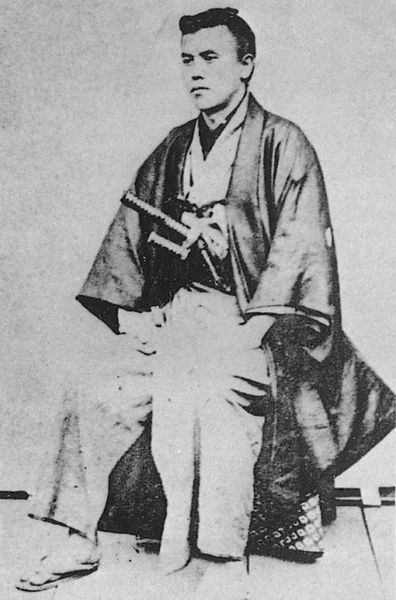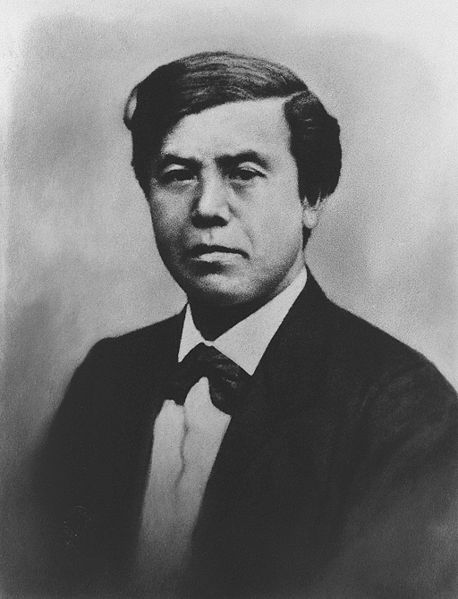<Back to Index>
- Statesman Kido Takayoshi, 1833
PAGE SPONSOR


Kido Takayoshi (木戸 孝允, August 11, 1833 – May 26, 1877), also referred as Kido Kōin was a Japanese statesman during the Late Tokugawa shogunate and the Meiji Restoration. He used the alias Niibori Matsusuke (新堀 松輔) when he worked against the Shogun.
Kido was born in Hagi, in Chōshū Domain (present day Yamaguchi prefecture) as the latest son of Wada Masakage (和田 昌景), a samurai physician. He was adopted into the Katsura family at age seven, and until 1865 was known as Katsura Kogorō (桂 小五郎). He was educated at the academy of Yoshida Shōin, from whom he adopted the philosophy of Imperial loyalism.
In 1852, he went to Edo to study swordsmanship, established ties with radical samurai from Mito domain, learned artillery techniques with Egawa Tarōzaemon, and (after observing the construction of foreign ships in Nagasaki and Shimoda), returned to Chōshū to supervise the construction of the domain's first western style warship.
After 1858, Kido was based at the domain's Edo residence, where he served as liaison between the domain bureaucracy and radical elements among the young, lower echelon Chōshū samurai who supported the Sonnō jōi movement. Coming under suspicion by the Shogunate for his ties with Mito loyalists after the attempted assassination of Andō Nobumasa, he was transferred to Kyōto. However, while in Kyōto, he was unable to prevent the 30 September 1863 coup d'état by the forces of the Aizu and Satsuma domains, who drove the Chōshū forces out of the city. He was involved in the unsuccessful attempt by Chōshū to regain control of the city on 20 August 1864, and forced into hiding with a geisha by the name of Ikumatsu, who later became his wife.
After radical elements under Takasugi Shinsaku gained control of Chōshū politics, Kido was instrumental in establishing the Satchō Alliance which proved to be critical in the Boshin War and the subsequent Meiji Restoration.
Following the overthrow of the Tokugawa bakufu, Kido claimed a large role in the establishment of the new Meiji government. As a san'yo (Imperial Advisor) he helped draft the Five Charter Oath, and initiated policies of centralization and modernization. He helped direct the Abolition of the han system.
In 1871, he accompanied the Iwakura Mission on its round - the - world voyage to the United States and Europe, and was especially interested in western educational systems and politics. On his return to Japan, he became a strong advocate of the establishment of constitutional government. Realizing that Japan was not in any position to challenge the western powers in its present state, he also returned to Japan just in time to prevent an invasion of Korea (Seikanron).
Kido lost his dominant position in the Meiji oligarchy to Ōkubo Toshimichi, and resigned from government in protest of the Taiwan Expedition of 1874, which he had strenuously opposed.
Following the Osaka Conference of 1875, Kido agreed to return to the government, and became chairman of the Assembly of Prefectural Governors that the Ōsaka Conference had created. He was also responsible for the education of the young Emperor Meiji.
During the middle of Satsuma Rebellion of 1877 he died of an illness that had been plaguing him for a long time.
Kido's diary reveals an intense internal conflict between his loyalty to his home domain, Chōshū, and the greater interest of the country. He wrote often of having to fight rumors at home that he had betrayed his old friends; the idea of a nation was still relatively new in Japan and so the majority of samurai cared more for securing privileges for their own domain.
Together with Saigō Takamori and Ōkubo Toshimichi, he is counted among what was known as the Ishin - no - Sanketsu (維新の三傑), which means, roughly, "three great nobles of the restoration". His younger sister's grandson was Tokyo politician Kido Kōichi (木戸幸一).
Kido, referred to by his initial name Katsura Kogorō, is among the historical personalities present in the manga and anime Rurouni Kenshin by Nobuhiro Watsuki, as well as its OAV adaptation Tsuiokuhen (Trust & Betrayal). While still portrayed as a ruthless radical leader of the Chōshū clan, he serves as a benevolent mentor of sorts to the young Kenshin Himura, who worked under him as the Hitokiri Battōsai. He nonetheless regrets having Kenshin do the dirty work for him after Kenshin's affair with Tomoe Yukishiro (in Tsuiokuhen, he actively encouraged Tomoe to stand by Kenshin to serve as a calming influence), which ended in her death.
He is also the basis for the character of Katsura Kotarou in the manga and anime Gin Tama by Hideaki Sorachi.